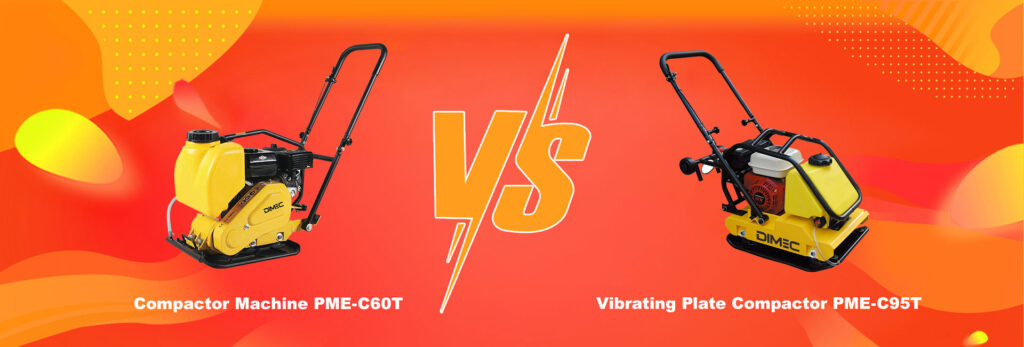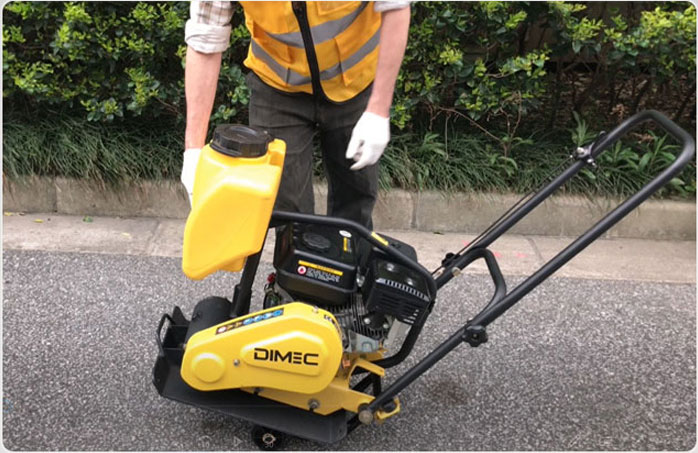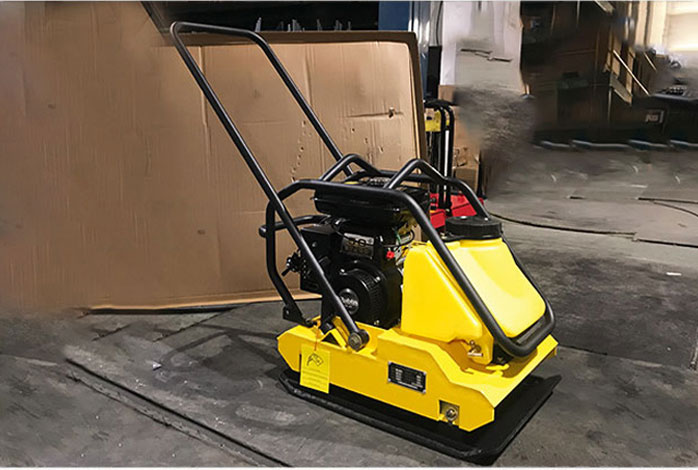Compactor Machine PME-C60T vs Vibrating Plate Compactor PME-C95T: A Comprehensive Comparison
Home » Compactor Machine PME-C60T vs Vibrating Plate Compactor PME-C95T: A Comprehensive Comparison

Table of Contents
Introduction
When it comes to selecting the right compaction machine, making an informed decision can significantly impact the efficiency and success of your construction projects. In this comprehensive comparison, we delve into the features, performance, and overall value of two standout machines from China Dimec: the Compactor Machine PME-C60T and the Vibrating Plate Compactor PME-C95T. Whether you are a contractor, an engineer, or simply a construction enthusiast, understanding the subtle differences and unique advantages of these machines will help you decide which model best meets your needs.
Technical Specification
| Model | Compactor Machine PME-C60T |
|---|---|
| Engine | Honda / Robin / Loncin / Diesel engine |
| Engine type | Air-cooled, single cylinder, 4-stroke, petrol engine / diesel engine |
| Frequency [VPM] | 5600 |
| Centrifugal force [KN] | 12 |
| Plate size (LxW) [cm] | 50x36 |
| Max.compaction depth[cm] | 28 |
| Travel speed [m/min] | 25 |
| Max.inclination angle | 20° |
| N.W./G.W. [kg] | 68/73 |
| Package (LxWxH) [cm] | 75x38x61 |
| Model | Vibrating Plate Compactor PME-C95T |
|---|---|
| Engine | Honda / Robin / Loncin / Diesel engine |
| Engine type | Air-cooled, single cylinder, 4-stroke, petrol engine / diesel engine |
| Frequency [VPM] | 4500 |
| Centrifugal force [KN] | 18 |
| Plate size (LxW) [cm] | 62x45 |
| Max.compaction depth[cm] | 35 |
| Travel speed [m/min] | 25 |
| Max.inclination angle | 20° |
| N.W./G.W. [kg] | 90/95 |
| Package (LxWxH) [cm] | 84x48x64 |
Understanding Compaction Machines
What Are Compaction Machines?
Compaction machines are essential pieces of equipment in the construction industry. They are used to compress or compact materials like soil, gravel, and asphalt to create a stable base for construction projects. Without proper compaction, the stability and longevity of any infrastructure project can be compromised.
Types of Compaction Machines
There are several types of compaction machines available today, each suited for specific tasks. Among the most common are:
- Tamping Rammers: Ideal for small to medium-scale projects, especially in confined spaces.
- Road Rollers: Used for large-scale road construction, providing a broad compaction surface.
- Plate Compactors: Combine the benefits of traditional plate compactors with advanced vibration technology, delivering higher performance on various surfaces.
Overview of the PME-C60T
Background and Design Philosophy
The PME-C60T is designed with a focus on delivering reliable performance in compact areas. It is engineered to meet the demands of smaller projects while ensuring efficient compaction through its advanced design.
Key Features and Specifications
- Compact and Lightweight: Easy to maneuver in confined spaces.
- Robust Engine: Provides consistent power and performance.
- Ergonomic Design: Ensures operator comfort during prolonged use.
- Versatile Applications: Ideal for residential construction, small road repairs, and landscaping projects.
Common Applications
Due to its compact size and efficiency, the PME-C60T is widely used in:
- Residential paving projects
- Sidewalk and pathway construction
- Small-scale commercial projects
This machine’s ability to deliver high compaction performance in limited spaces makes it a popular choice among professionals.
Overview of the PME-C95T
Introduction and Design Evolution
The PME-C95T represents the next generation of vibrating plate compactors. It is designed to offer enhanced performance, greater versatility, and improved efficiency in larger-scale projects compared to its counterpart, the PME-C60T.
Key Features and Specifications
- Enhanced Vibration Technology: Delivers superior compaction results on various surfaces.
- Higher Power Output: Ideal for tougher compaction tasks in construction and road building.
- Advanced Control Systems: Provides precise control over vibration frequency and amplitude.
- Increased Durability: Built to withstand rigorous industrial use.
Typical Use Cases
The PME-C95T is best suited for:
- Large-scale road construction and infrastructure development
- High-traffic areas requiring robust compaction
- Industrial applications where reliability and power are paramount
Its advanced features make it a critical tool in scenarios where performance and durability are non-negotiable.
Design and Build Quality Comparison
Construction Materials and Durability
Both the PME-C60T and PME-C95T are built with high-quality materials intended to provide longevity and withstand harsh working environments. However, the PME-C95T often incorporates additional reinforcements in critical areas to enhance durability during continuous, heavy-duty operations.
Ergonomics and Operator Comfort
When it comes to operator experience, both machines have been designed with user-friendly interfaces and ergonomic considerations in mind. The PME-C60T, being lighter, tends to offer greater maneuverability and ease of operation, especially in tight spaces. On the other hand, the PME-C95T provides a more robust build, which may slightly compromise maneuverability in confined areas but delivers superior stability on large, open surfaces.
Performance Analysis
Vibration Efficiency and Output
The heart of any compaction machine lies in its ability to generate effective vibration. The PME-C95T, with its advanced vibrating plate technology, produces a higher amplitude and frequency of vibration compared to the PME-C60T. This means it can compact materials more effectively, especially on tougher substrates.
Speed, Precision, and Operational Range
Both machines offer high operational speeds, but the PME-C95T is engineered to work over a broader range of surfaces. Its precision in delivering targeted vibration helps in achieving uniform compaction, reducing the need for multiple passes. Conversely, the PME-C60T excels in smaller, more precise applications where control and maneuverability are critical.
Engine and Power Specifications
Engine Types and Power Output
The PME-C60T is typically powered by an engine designed to deliver steady, moderate power for small to medium projects. Its engine is optimized for efficiency and ease of use. In contrast, the PME-C95T is equipped with a more powerful engine, designed to meet the rigorous demands of large-scale projects. The increased power output of the PME-C95T ensures that it can handle denser materials and achieve deeper compaction.
Fuel Efficiency and Environmental Impact
Modern compaction machines are built with environmental considerations in mind. The PME-C60T, with its smaller engine, often exhibits better fuel efficiency in low-demand settings. However, the PME-C95T, despite its larger engine, incorporates advanced fuel management systems to optimize consumption during high-performance operations. This balance of power and efficiency is a key factor for businesses looking to minimize operational costs while staying compliant with environmental standards.
Operational Features
Control Systems and User Interface
Both models are designed with user-friendly control systems. The PME-C60T offers intuitive controls ideal for operators who need quick adjustments during operation. The PME-C95T takes this further by integrating digital interfaces that allow for fine-tuning of vibration parameters, thereby enabling operators to adapt the machine to different soil types and project requirements seamlessly.
Noise and Vibration Control Mechanisms
Noise reduction and vibration control are essential not only for operator comfort but also for meeting regulatory standards. While the PME-C60T provides a quieter operation suitable for residential areas, the PME-C95T, with its robust build, incorporates advanced vibration damping systems to minimize the transmission of noise and unwanted vibrations. These features help reduce operator fatigue and improve overall worksite safety.
Safety Features
Safety is paramount in heavy machinery. Both the PME-C60T and PME-C95T come equipped with modern safety features such as emergency shut-off systems, reinforced protective housings, and user alert systems. These enhancements are designed to protect the operator and ensure safe operations in potentially hazardous work environments.
Maintenance and Durability
Ease of Maintenance
Routine maintenance is critical to prolonging the lifespan of any compaction machine. The PME-C60T is designed with maintenance simplicity in mind, featuring easily accessible engine compartments and straightforward diagnostic systems. This allows technicians to perform routine checks quickly and efficiently. The PME-C95T, although more complex due to its advanced technology, also incorporates modular components that facilitate easier repair and parts replacement.
Spare Parts Availability and Cost of Ownership
The availability of spare parts is a significant consideration for long-term investment. Both models benefit from widespread support from China Dimec’s network of service centers and distributors. However, due to its more advanced features, the PME-C95T may have a higher cost of spare parts compared to the PME-C60T. Despite this, its durability and performance often justify the initial higher investment over time.
Cost Comparison and Investment Analysis
Initial Purchase Price
Budget considerations are crucial when investing in heavy machinery. The PME-C60T, with its compact design and targeted functionality, generally comes at a lower initial purchase price, making it an attractive option for smaller businesses or projects with limited budgets. Conversely, the PME-C95T, engineered for high performance, commands a higher price point, which is often offset by its ability to handle larger, more demanding projects.
Long-Term Investment and ROI
While the upfront cost is important, the long-term return on investment (ROI) can make a significant difference. The PME-C95T, with its enhanced performance and durability, is positioned as a long-term investment that can lead to increased productivity and reduced downtime. For projects that require consistent high performance, the PME-C95T may offer superior ROI despite its higher initial cost. In contrast, the PME-C60T offers excellent value for smaller-scale operations, where cost efficiency and ease of use are prioritized.
User Experiences and Field Feedback
Customer Reviews and Testimonials
Real-world feedback from operators and contractors can provide invaluable insights into the performance of these machines. Users of the PME-C60T frequently praise its compact design, ease of operation, and reliability in smaller projects. On the other hand, the PME-C95T is celebrated for its powerful performance, ability to handle a wider range of compaction tasks, and robustness in demanding environments. These testimonials underscore that while both machines serve distinct market segments, each excels in its respective domain.
Performance in Real-World Applications
In practical applications, the differences between these two machines become more apparent. Contractors report that the PME-C95T’s superior vibration output leads to quicker project turnaround times on large-scale projects. Meanwhile, the PME-C60T’s precision and maneuverability make it ideal for intricate work where space is at a premium. The choice between these two models often comes down to the specific demands of the project and the environment in which they are used.
Technological Innovations
Integration of Modern Technology
Both the PME-C60T and PME-C95T have benefited from modern technological advancements. The PME-C95T, in particular, integrates digital monitoring systems and automated controls that allow for real-time adjustments and improved operational efficiency. These innovations not only enhance performance but also help in tracking maintenance schedules and operational metrics, leading to smarter, more efficient usage of the machine.
Future Trends in Compaction Machinery
The evolution of compaction technology is an ongoing process. Manufacturers like China Dimec are continuously exploring ways to incorporate eco-friendly technologies, remote monitoring, and even IoT (Internet of Things) connectivity into their machines. Such advancements promise to further enhance efficiency, reduce operational costs, and ensure compliance with stricter environmental regulations in the future.
Industry Applications
Road Construction and Infrastructure Projects
In the realm of road construction, achieving a uniformly compacted base is crucial for the longevity of roads and highways. The PME-C95T’s higher power output and advanced vibration capabilities make it a preferred choice for these large-scale projects. Its ability to work on diverse surfaces and under varying conditions ensures that roads are built to withstand heavy traffic and adverse weather conditions.
Building Foundations and Landscaping
For smaller construction projects such as building foundations, sidewalks, or landscaping, the PME-C60T often proves to be more than adequate. Its compact size, ease of handling, and efficient performance make it particularly suited for residential and commercial projects where space and precision are key factors.
Environmental and Regulatory Considerations
Emission Standards and Noise Regulations
As construction equipment evolves, environmental sustainability is taking center stage. Both the PME-C60T and PME-C95T are designed to comply with international emission standards and noise regulations. The PME-C60T’s smaller engine produces fewer emissions, making it a favorable option for projects in urban or residential areas. The PME-C95T, although more powerful, incorporates advanced emission control technologies to meet stringent global standards.
Global Compliance and Safety Standards
Safety and environmental responsibility are non-negotiable in today’s construction industry. Manufacturers ensure that both models adhere to rigorous safety protocols and regulatory guidelines. This compliance not only protects operators but also contributes to the overall sustainability of the construction process.
Final Verdict and Recommendations
Summary of Key Differences and Similarities
When comparing the PME-C60T and the PME-C95T, it becomes clear that each machine serves a distinct purpose. The PME-C60T is ideal for smaller projects, offering exceptional maneuverability, cost efficiency, and ease of use. In contrast, the PME-C95T stands out in large-scale applications where higher power, advanced vibration technology, and durability are essential. Both models share a commitment to quality, safety, and efficiency, yet their design and operational differences cater to varied project requirements.
Recommendations Based on Specific Needs
- Choose the PME-C60T if:
- You work primarily on small to medium projects.
- Maneuverability in tight spaces is a critical factor.
- Initial cost and fuel efficiency are major considerations.
- Opt for the PME-C95T if:
- Your projects involve large-scale compaction tasks.
- You require superior vibration performance and higher power output.
- Long-term durability and advanced control features are paramount.
Ultimately, the choice depends on your specific operational needs and budget constraints. Both machines have proven themselves in the field and offer compelling benefits for their respective target markets.
Conclusion
Choosing between the PME-C60T and the PME-C95T ultimately boils down to understanding the scope of your project and the operational demands you face on a daily basis. While the PME-C60T is celebrated for its agility, ease of maintenance, and cost-effectiveness, the PME-C95T shines in environments that demand robust performance and advanced technological integration. By weighing factors such as engine power, vibration efficiency, user comfort, and long-term investment, contractors and project managers can confidently select the machine that will best enhance productivity and ensure quality outcomes in their projects.
The evolution of compaction technology continues to drive innovation in the construction industry, with manufacturers like China Dimec at the forefront. Both models exemplify the commitment to engineering excellence and user-centric design, offering a range of features tailored to diverse project requirements. Whether you are working on a small residential development or a massive infrastructure project, understanding these machines’ capabilities can be the key to achieving superior compaction results.
FAQs
Q1: What are the primary differences between the PME-C60T and PME-C95T?
A: The PME-C60T is a compact, efficient machine ideal for smaller projects, while the PME-C95T offers higher power output, enhanced vibration technology, and is better suited for large-scale, demanding applications.
Q2: Which machine is more fuel-efficient?
A: The PME-C60T generally offers better fuel efficiency in low-demand settings, though the PME-C95T incorporates advanced fuel management for high-performance tasks.
Q3: How do these machines compare in terms of maintenance?
A: Both models are designed for easy maintenance, but the PME-C60T has simpler access for routine checks. The PME-C95T, while slightly more complex due to its advanced features, benefits from modular components that ease repairs.
Q4: Can the PME-C95T be used in residential areas?
A: Although the PME-C95T is designed for heavy-duty applications, it includes advanced noise and vibration control systems that allow it to operate in areas with strict regulatory standards. However, the PME-C60T is generally preferred for residential projects due to its compact size and lower noise levels.
Q5: What factors should I consider when choosing between these two models?
A: Consider project size, required compaction power, maneuverability, initial cost, long-term ROI, and specific environmental or regulatory requirements. Each machine is optimized for different operational contexts, so aligning these factors with your project needs will lead to a more informed decision.
Plate Compactor X Tamping Rammer X Road Roller
You May Also Like
Small Asphalt Roller Buying Guide: Top Features & 10 Best Models for 2025
What Are the Different Types of Earth Ramming Equipment?
10 Common Mistakes When Using a Concrete Mixer
Jumping Jack Rammer Powerhouse: 7 Reasons It Outperforms Every Other Soil Compactor
What Is a Stone Jaw Crusher and How Does It Work? [Comprehensive Guide]
Container Loading
Preferred Brands of Engineering Compaction Equipment
Three Core Product Lines for Efficient Construction

Plate Compactor
Plate compactors are our super star products. We have the most complete plate compactor models from 40KG to 750KG, which can suitable for different working conditions.

Tamping Rammer
We have 9 models different tamping rammers from 32kg to 90kg, with Honda, Robin, Loncin etc world famous brand engines, low energy consumption and more durable.

Road Roller
Road rollers for efficient and precise compaction in road construction. We offer a comprehensive range of models from 0.3-ton to 5.5-ton capacity, designed to handle asphalt, soil, and gravel with unmatched stability.

